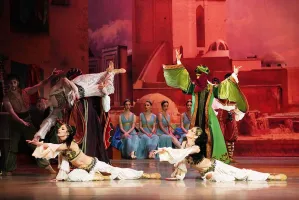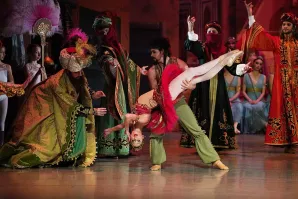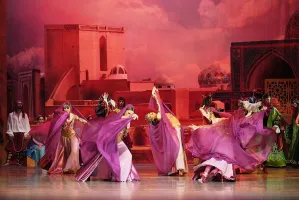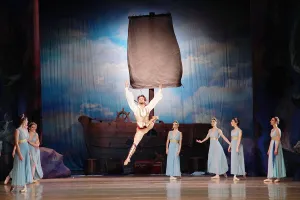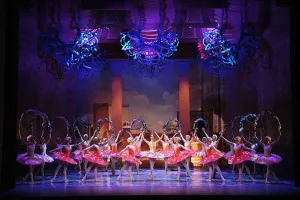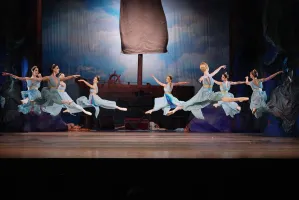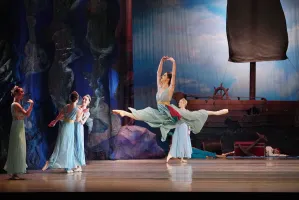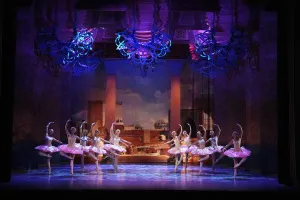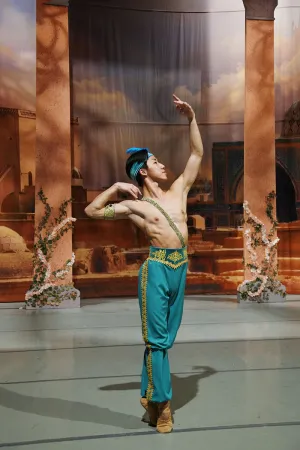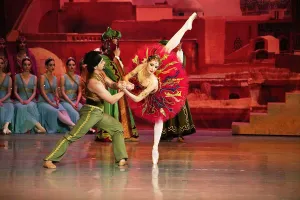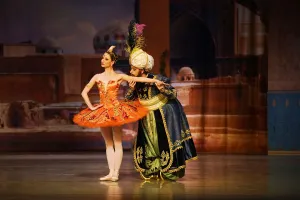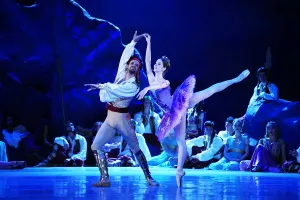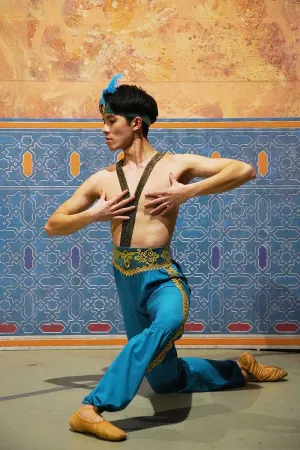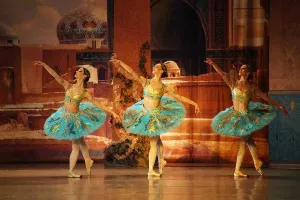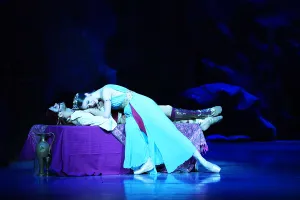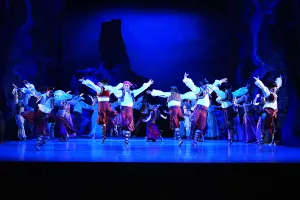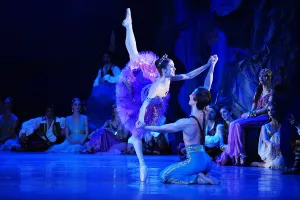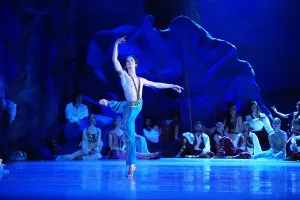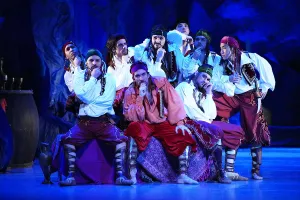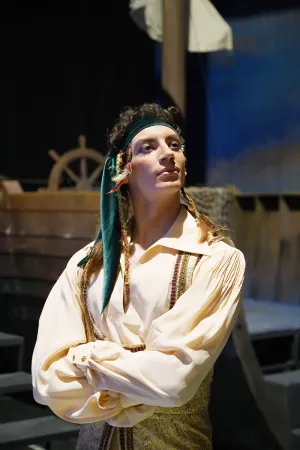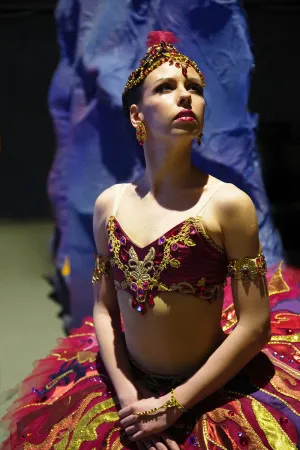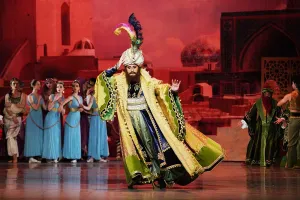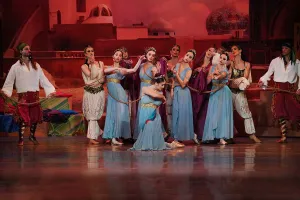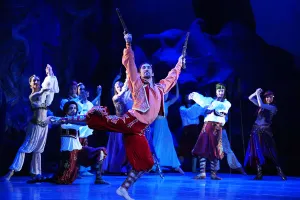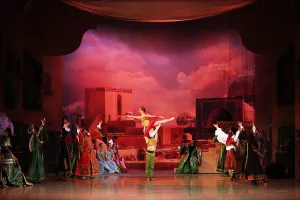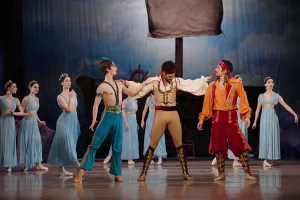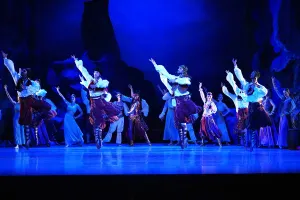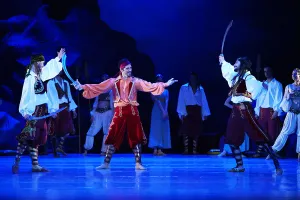Le Corsaire
a ballet to the music by Adolphe Adam and group of composers

The Pirate/Le Corsaire
FOR THE FIRST TIME ON THE NATIONAL THEATRE STAGE
The Pirate/Le Corsaire belongs to the opus of old, grandiose ballet productions of the 19th century and possesses all the elements necessary for success and longevity, despite the passage of time and new tendencies in the sphere of art. By looking at the libretto, we discover the story of pirates, who not only wrestle with the sea waves, but on land they engage in heroic deeds for the sake of love. Coloured by the musical sensibility of different composers, the romantic story of love and passion, interwoven with the intrigues from the Orient, takes us into a world of attractive scenes, exotic motifs full of jewels, splendour, but also the struggle for freedom and personal integrity. A classical ballet show, like The Pirate, requires a serious ballet ensemble educated in the tradition of strict ballet academicism. Also, it requires several female and male lead roles, as well as a large male ensemble, which is unusual for ballet performances of the Romantic era, which particularly asserts the female ensemble and the prima ballerina’s dominance on the stage. The combination of ballet classicism, exotic character dances, virtuoso female and male dancing, in addition to colourful magnificent set and bewitching costumes inspired by the Orient, are a sufficient recipe for success that has followed this ballet for over 150 years on numerous world stages.
Despite its grandiosity, this ballet spectacle had an extraordinary path of artistic development, as well as numerous versions by various choreographers. And even the chronology of performances on world stages is quite irregular, in terms of numerous productions on stages in the Soviet Union, for example, or performances on Western stages, which took place only by the end of the 20th century. The premiere of the ballet The Pirate was held on January 23, 1856 at the Paris Opera (Théâtre Impérial de l’Opéra), choreographed by Joseph Mazilier, who also wrote the libretto together with J-V. de Saint-Georges (Jules-Henri Vernoy de Saint-Georges).
The libretto was based on the epic poem The Corsair (1814), by Lord Byron, a famous British poet from the Romantic period. The premiere of the ballet in Russia took place in Saint Petersburg, two years after the premiere in Paris, in 1858. The choreographer was Jules Perrot, assisted by Marius Petipa, who independently staged several ballet sections, which later became extremely popular. During his decades-long career, Petipa staged four versions of The Pirate and determined future choreographic creations, but he also confirmed his status as the founder of classical ballet academism.
Thanks to numerous revisions and new choreographic redactions, throughout its history, The Pirate has undergone constant and radical changes. Another curiosity is the fact that, in addition to the basic musical score by Adolphe Adam, the music by numerous other composers is also used in this ballet, which gave the choreographers more freedom, but also the possibility to add new dance routines. Accordingly, we will mention the versions of Alexander Gorsky, Samuil Andrianov, Konsatаntin Sergeevich, but also the redaction of Agrippina Vaganova.
It is interesting that the ballet The Pirate was not in the repertoire of Western theatres for most of the previous century. It was not until the late 1990s that we saw The Pirate productions on the stage of the Boston Ballet and the famous New York ABT (American Ballet Theatre). In Western Europe, we saw the productions of The Pirate only after the year 2000. The English National Ballet, for example, performed this piece for the first time only in 2013, choreographed by A.M. Holmes, who has already staged the same ballet on American stages.
We should also mention the great comeback of The Pirate to the Bolshoi Theatre stage in 2007, choreographed by Y. Burlaka and A. Ratmansky, who decided to go back to their roots, using the libretto, musical score, setting and costumes of the choreographic version staged by Marius Petipa back in 1899, which had not been seen on the Russian stages for decades.
The choreography of the ballet The Pirate/Le Corsaire for the National Theatre Ballet was created by Bakhram Yuldashev based on the instructions of Marius Petipa and Pyotr Gusev.
This is a special moment for the National Theatre Ballet, a year in which it celebrates a significant jubilee, the centenary of its existence. Back in 1923, a new chapter of our cultural history was opened. With the help of artists who came from the very source of ballet art, the dance arrived, beautiful and lavish and shone on our stage. For one hundred years now we have been writing the golden pages of our ballet history adding another pearl of classical ballet literature to it. The premiere of the ballet The Pirate/Le Corsaire, which until now has not been performed on our stage makes the celebration of the important jubilee of the National Theatre Ballet in Belgrade even more exclusive, and ballet art lovers have the privilege of seeing this spectacle in an integral version for the first time.
Brankica Knežević
ADOLPHE - CHARLES ADAM 1803 - 1856
Composer and music critic
The rich creative oeuvre of this composer is confirmed by dozens of opera and ballet scores he created. He gained world fame and a special place in the history of ballet art with the music for the ballets Giselle and Le Corsaire, which have been continuously performed on stages around the world since 1841 and 1856, respectively. The secret of the longevity of his works is hidden in the clear and interesting music with which he created a special emotional thread and connected the audience with the stage performance in a simple way.
LIBRETTO
Somewhere on the Ionian coast, in the shadow of political conflicts between Greece and Turkey.
Prologue
Lord Byron writes a story about a pirate. Storm rages on the high seas. A group of pirates from the Mediterranean, led by Conrad, Birbanto and the slave Ali, struggle to save a sinking ship.
Act One
THE COAST
The sea washed Conrad and his friends ashore. Young Greek women, led by Medora and Gulnare, come to their aid. Conrad immediately falls in love with Medora and reveals to her that he is a pirate. In the distance they spot a group of Turkish slave traders. Medora and Gulnare warn the pirates of the danger and manage to hide them. The Turks soon capture the girls. All this is witnessed by Lankendem, a slave trader. The girls are taken to the slave market, and the pirates vow to save them.
THE SLAVE MARKET
Amidst the hustle and bustle in the market, Seyd Pasha appears in search of beautiful girls for his harem. Lankendem presents his booty from faraway travels, captured girls from Palestine and Algeria. They bring Gulnare to him and he, captivated by her beauty, immediately decides to buy her. The dance of Gulnare and Lankendem ensues - Pas d’Esclave. However, Lankendem saves the best for last - the beautiful Medora. She is such a beauty that Seyd Pasha decides to buy her at any price. A new buyer suddenly appears, in whom a buffled Medora recognizes Conrad in disguise. Conrad and his companions suddenly throw off their cloaks and show to everyone that they are armed pirates. Taking Medora away, they also capture Lankendem and flee towards the sea.
Act Two
THE CAVE
Conrad and his party take Medora and the other girls to a pirate cave full of treasures. The pirates rejoice because of the rich booty from the market, but also because they managed to rescue the young women. They celebrate by dancing The Pirate Dance and Danse Des Forbans. Medora and Conrad confirm their love for each other. Slave Ali swears to Medora that he will be her faithful servant. To the delight of all the pirates, Medora dances with Conrad and Ali - Pas d’ action The girls beg Medora to ask Conrad to help them free themselves from slavery and return home. He agrees to help them, but Birbanto and the other men are against it and a conflict ensues. Conrad is adamant and Medora manages to free the girls. Lankendem notices disagreement among the pirates and, in exchange for his freedom, he offers Birbanto a potion that would incapacitate Conrad. They pour the liquid into a bouquet of flowers that Lankendem gives to Medora. She gives it to Conrad as a token of gratitude for his chivalry. He smells the flowers and immediately dozes off. Soon, Lankendem and Birbanto succeed in abducting Medora for the second time, but she manages to wound Birbanto in self-defence. Conrad wakes up and swears to free Medora.
Act Three
Seyd Pasha’s Harem
Gulnare is the jewel of Pasha’s harem. Lankendem soon appears with three gorgeous girls, who perform a sumptuous Odalisque dance. When he finally introduces Medora, Seyd Pasha buys her, thrilled. Sad Medora becomes more cheerful once she is reunited with Gulnare. Seyd Pasha, enraptured by the beauties, imagines that they are flowers in his garden. Medora and Gulnare dance ravishingly in the garden with other girls in the famous vision of Le Jardin Animé. Suddenly, mysterious pilgrims arrive in the palace during the evening prayer. Astonished Medora recognizes Conrad and his disguised companions who manage to save Medora and Gulnare, but also to take revenge on Pasha and Lankendem. Upon release, Medora recognizes the traitor Birbanto by the wound on his arm and reveals this to Conrad. The moment of revenge has come and Conrad kills Birbanto.
Epilogue
Lord Byron finishes the story of the pirate and throws his notes in the air euphorically. Conrad, Medora and other pirates sail the high seas as new adventures await them.
Legend has it that the idea for The Pirate came from the last French Empress, Marie Eugenie, who was a passionate ballet lover. The Empress, allegedly, proposed that a ballet be created based on the dramatic poem Manfred by the Romantic poet Lord Byron. This proposal, however, was not materialized due to the increasing Empress’ preoccupation with state affairs. However, the creators of The Pirate found inspiration in a Byron’s poem that shares the name with the ballet, so we can say that the Empress’ proposal was an important guidance. This gives The Pirate a unique place in history as the only ballet to which the Empress of the French Empire gave its contribution.
The Romantic era was characterized by a fascination with larger-than-life characters and the motifs of the exotic, the mysterious and the unknown. The aforementioned Lord Byron was one of the leading poets of the Romantic period, and his poetry often addressed the themes of love, passion and rebellion, which are also present in The Pirate ballet. Byron’s poem of the same name, which inspired the creation of the ballet, is one of his most popular works, and among other things, it tells a story about the love between a pirate and a beautiful slave girl.
Đorđe Kosić
BAKHRAM YULDASHEV
Choreographer
Maître de scène, a recognition of the Ministry of Culture of the Russian Federation (1994)
Honoured Artist of the Russian Federation (1997)
He was born in 1963 in Tashkent, USSR, where he graduated from the State Ballet School. He graduated from the Russian Ballet Academy in Moscow, where he earned a diploma of a ballet artist - dancer. He then studied at the Rimsky-Korsakov State Ballet Conservatory in Moscow and at the Faculty of Choreography in Kyiv, where he was conferred the title of a ballet master, ballet pedagogue in 2008.
As a principal ballet dancer, he was engaged in the following theatres:
State Academic Ballet Theatre - Saint Petersburg
State Opera and Ballet Theatre in Kazan
State Opera and Ballet Theatre - Ufa
National Theatre - Istanbul
Mikhailovsky Academic Theatre - Saint Petersburg
He performed all over the world at numerous gala concerts with the Bolshoi Theatre stars.
As a ballet master, he was engaged in numerous theatres throughout Europe, including the National Theatres in Bratislava and Prague, as well as the National Theatre in Belgrade.
As a ballet pedagogue, he worked at the State Ballet Conservatory in Bratislava, Brno and Nancy.
His current engagement is at the Slovak National Theatre as a ballet pedagogue, and at the State Ballet Conservatory in Bratislava as a lecturer.
On the stages of European national theatres, he staged the following ballets:
Sleeping Beauty – Antwerp (2001), Bratislava (2002), Brno (2017)
The Pirate - Bratislava (2005), Prague (2007)
ANA ZORANA BRAJOVIĆ
Conductor
Ana Zorana Brajović was born in Belgrade in 1975. Brajović started her career as a pianist in 1991 with numerous concerts in Serbia and abroad. She graduated at the Piano Department, mentored by Professor Mirjana Šuica Babić, and later on, she obtained her Master’s Degree in conducting, mentored by Professor Jovan Šajnović. Starting from 1st October 1994, she began working in the Opera of the National Theatre in Belgrade as an assistant conductor.
In 1995, she held a Promenade Concert at the “Ilija M. Kolarac” Endowment accompanied by the Symphony Orchestra of the Serbian Broadcasting Corporation, when, among other pieces in a fairly demanding repertory, she played and conducted Mozart’s Concerto in C minor. The same year, she started her career as a conductor and conducted Mozart’s Magic Flute for the first time, thus becoming the youngest conductor who has ever performed in Belgrade Opera. Ana Zorana Brajović was awarded with the October Award for achievements in music art in 1995; she was the youngest candidate at the competition. During season 2000/01, she was appointed to the position of permanent conductor of the Opera and Ballet of the National Theatre.
Ana Zorana won the first prize for performance and co-repetition in “Boris Hristov” Competition in Sofia in 2000. She received Fulbright scholarship for academic year 2003/04 and studied at the Peabody Conservatory, Baltimore, USA, in the class of Professor Gustav Meier. In 2003, she recorded a CD – Deus Absconditus, suite by Aleksandar Kostić, in cooperation with the Radio Symphony Choir and Orchestra.
In 2006, Ana Zorana conducted at the world premiere of opera on Nikola Tesla, Violet Fire, by Jon Gibson, in the National Theatre in Belgrade, and the same year, she participated in the Brooklyn Music Festival in New York, in cooperation with musicians of the Metropolitan Theatre.
She performed in opera houses in Baltimore and Washington, DC.
She has been regularly performing with the Symphony Orchestra of the Serbian Broadcasting Corporation.
In cooperation with the Philharmonic Orchestra of Sarajevo, she conducted Giselle in the National Theatre in Sarajevo, in 2011.
In period between 2007 and 2012, she conducted in the regular repertoire of the Opera and Ballet of the National Theatre in Belgrade and revived operas The Barber of Seville (2010) and The Masked Ball (2011).
With performance of Rossini’s The Barber of Seville, she celebrated 20 years of her artistic career on 24th November 2011.
In period between 2014 and 2016, she worked as an Acting Manager of the Opera of the National Theatre in Belgrade. In 2019, she conducted the premiere of the opera Koštana by Petar Konjović.
KATARINA GRČIĆ NIKOLIĆ
Costume Designer
Graduated in 1993 at the Faculty of Applied Arts in Belgrade, Costume Department. Member of the Applied Artists and Designers Association of Serbia since 1995.
Since 1999 she has been a Costume Designer at the National Theatre in Belgrade.
She has collaborated with numerous renowned directors and choreographers.
Ballet Productions – selected Works:
The Rite of Spring (1997), Swan Lake (1998), The Taming of the Shrew (2009),The Picture of Dorian Gray (2015), Coppélia (2015), Eugene Onegin (2017), Michelangelo (2021)
She is the winner of the Joakim Vujić Theatre Festival Award in 2000 and Annual Award of the National Theatre in Belgrade in 2016.
OLGA ĐURĐEVIĆ
Stage Designer
She graduated and specialized at the Florence Academy of Fine Arts at the Theatre, TV and Film Scenography Department. After her studies, she went to Milan, where she collaborated with the avant-garde theatre group Phoebe Zeitgeist. At the same time, she has created scenographic and visual solutions for the fashion industry, music videos and video scenography, as well as 3D animation in film post-production.
Selected works:Ballets Don Quixote, The Nutcracker, Serbian National Theatre - Novi Sad
Krypton, The King’s Daughter, The Machine - foreign film productions
Premiere performance
Premiere March 19, 2023
Main stage
ballet to the music by Adolphe Adam and group of composersBallet in three acts
Le Corsaire
After the poem The Corsair of George Gordon Byron
Music Adolphe Adam
Léo Delibes, Cesare Pugni, Duke Peter of Oldenburg, Riccardo Drigo, Albert Zabel, Julij Gerber
Choreographer Bakhram Yuldashev choreographic version after M. Petipa, P. Gusev
Costumes Katarina Grčić Nikolić
Sets Olga Đurđević
Conductor Ana Zorana Brajović
Artistic Director Ana Pavlović
Executive Director Smiljana Stokić
Producers Brankica Knežević, Gojko Davidović
Directing Consultant Đorđe Makarević
Choreographer`s Assistants Marija Bajčetić, Jovan Veselinović
Repetitors Dalija Imanić, Tamara Ivanović, Ana Pavlović, Konstantin Tešea
Ballet Ensemble and Orchestra of the National Theatre in Belgrade

